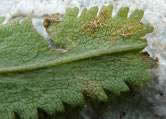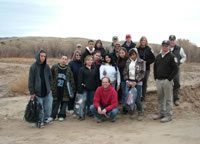Rocky Mountain Research Station
Welcome to the Rocky Mountain Research Station
Welcome from Sam Foster, RMRS Station Director
 Welcome to the US Forest Service,
Rocky Mountain Research Station's home page.
I am very proud of our employees and the work that they do.
We are here to serve the American public, and through this website we have provided a host of information that
we think will help you understand our natural environment. Our research results help decision makers
develop informed choices about the conservation of natural resources. Please explore our website and
learn what we have to offer. You will find links to websites for our research programs.
The Station's published research is available free of charge through this website.
Welcome to the US Forest Service,
Rocky Mountain Research Station's home page.
I am very proud of our employees and the work that they do.
We are here to serve the American public, and through this website we have provided a host of information that
we think will help you understand our natural environment. Our research results help decision makers
develop informed choices about the conservation of natural resources. Please explore our website and
learn what we have to offer. You will find links to websites for our research programs.
The Station's published research is available free of charge through this website.
Science Program Areas and Program Directories
What's New
Rocky Mountain Riparian Digest
 The Rocky Mountain Riparian Digest presents the many facets of riparian research at the station.
Included are articles about protecting the riparian habitat, the social and economic values of riparian environments,
watershed restoration, remote sensing tools, and getting kids interested in the science. This large (12 MB)
24 page document
is available for
download.
The Rocky Mountain Riparian Digest presents the many facets of riparian research at the station.
Included are articles about protecting the riparian habitat, the social and economic values of riparian environments,
watershed restoration, remote sensing tools, and getting kids interested in the science. This large (12 MB)
24 page document
is available for
download.
Climate Change Resource Center
 The Climate Change Resource Center is a reference Web site for resource managers and decision
makers who need information and tools to address climate change in planning and project implementation on
lands in the West. Changing climates have already catalyzed changes in environments throughout the West, and
future effects are expected to be greater. Although future scenarios are daunting, managers can do much to
promote adaptation to climate change and encourage reduction of human effects on climate.
The Climate Change Resource Center is a reference Web site for resource managers and decision
makers who need information and tools to address climate change in planning and project implementation on
lands in the West. Changing climates have already catalyzed changes in environments throughout the West, and
future effects are expected to be greater. Although future scenarios are daunting, managers can do much to
promote adaptation to climate change and encourage reduction of human effects on climate.
Invasive Species Science Update Newsletter

The
Invasive Species Science Update
newsletter publishes contributions concerning the ecology and management of invasive species. Articles in this maiden
issue
include the expansion of the RMRS invasive plants program, fire effects on invasive species,
and the efficacy of mitigation
efforts on invasive plant impacts.
The newsletter will be published three times yearly.
RMRS Hosts "More Kids in the Woods" Project

Recently, the Rocky Mountain Research Station (RMRS) Albuquerque Laboratory received funding to support a "More Kids in the Woods" field day targeting non-traditional and minority high school students attending either the School on Wheels Alternative High School located in Albuquerque, New Mexico, or high schools located on any of New Mexico's 19 Indian pueblos. The School on Wheels, serving students who have been unsuccessful in traditional educational settings, emphasizes small classes and a "one-room schoolhouse" curriculum to help students become successful citizens, family members and employees.

Featured Science
Biocontrol Insect Exacerbates Invasive Weed
 Biocontrol agents, such as insects, are often released outside of their native ranges to control invasive plants.
But scientists in Montana have found that through complex community interactions among deer mice, native plants
and seeds, the presence of an introduced fly may exacerbate the effects of the invasive plant it was meant to control.
The authors report their results in the September issue of the journal Ecological Applications.
Biocontrol agents, such as insects, are often released outside of their native ranges to control invasive plants.
But scientists in Montana have found that through complex community interactions among deer mice, native plants
and seeds, the presence of an introduced fly may exacerbate the effects of the invasive plant it was meant to control.
The authors report their results in the September issue of the journal Ecological Applications.

Listen
to a podcast of Pearson speaking about this paper in ESA’s Field Talk podcast series.
Fuels Reduction and Restoration
 The Middle Rio Grande of New Mexico is the most extensive remaining cottonwood forest in
the southwest. Alterations caused by humans—damming and channeling the river, controlling floods, and
planting non-native trees—have disrupted the cycles of the earlier ecosystem. Without periodic flooding,
native cottonwoods cannot regenerate. Invasive exotic plants have filled in the gaps and open spaces,
increased fuel loads, and continue to replace
native trees and shrubs after wildfires.
An array of fuel treatments applied to study sites reduced invasive woody plants.
Survival rates of transplanted native plant species were high.
Restoration had various effects on birds, animals, amphibians, and reptiles.
The Middle Rio Grande of New Mexico is the most extensive remaining cottonwood forest in
the southwest. Alterations caused by humans—damming and channeling the river, controlling floods, and
planting non-native trees—have disrupted the cycles of the earlier ecosystem. Without periodic flooding,
native cottonwoods cannot regenerate. Invasive exotic plants have filled in the gaps and open spaces,
increased fuel loads, and continue to replace
native trees and shrubs after wildfires.
An array of fuel treatments applied to study sites reduced invasive woody plants.
Survival rates of transplanted native plant species were high.
Restoration had various effects on birds, animals, amphibians, and reptiles.

Consequences of Bark Beetle Outbreaks on Mountain Watersheds
 Widespread bark beetle outbreaks and subsequent forest management activities will alter landscapes throughout the West for the next century, yet little is currently known about how this natural disturbance will affect mountain watersheds and the quantity and quality of the water they produce.
Studies were established along four streams to measure the impacts of the beetle kill on stream channel characteristics and large wood loading.
Preliminary details are available.
Widespread bark beetle outbreaks and subsequent forest management activities will alter landscapes throughout the West for the next century, yet little is currently known about how this natural disturbance will affect mountain watersheds and the quantity and quality of the water they produce.
Studies were established along four streams to measure the impacts of the beetle kill on stream channel characteristics and large wood loading.
Preliminary details are available.

ERMiT - Erosion Risk Management Tool
 Scientists with the RMRS
Moscow Forestry Sciences Laboratory,
along with the Agricultural Research Service, have developed
ERMiT - Erosion Risk Management Tool, an online program that
predicts post-fire erosion.
ERMiT incorporates variability into predicting erosion and allows users to estimate
the effectiveness of mitigation efforts such as seeding, applying mulch, and installing
logs on hillslopes.
Scientists with the RMRS
Moscow Forestry Sciences Laboratory,
along with the Agricultural Research Service, have developed
ERMiT - Erosion Risk Management Tool, an online program that
predicts post-fire erosion.
ERMiT incorporates variability into predicting erosion and allows users to estimate
the effectiveness of mitigation efforts such as seeding, applying mulch, and installing
logs on hillslopes.

Recent Publications
Visit
RMRS Publications for
access to all station publications. Printed copies of all station publications can be
ordered
free of charge.
For externally refereed publications, visit either
|
|



 Rocky Mountain Research Station
Rocky Mountain Research Station
 Science Program Areas
Science Program Areas
 Hot Topic: Climate Change
Hot Topic: Climate Change
 Hot Topic: Aspen
Hot Topic: Aspen
 Research Laboratories
Research Laboratories
 Tools, Applications and Data
Tools, Applications and Data
 People
People
 About RMRS
About RMRS
 Contact RMRS
Contact RMRS
 Search
Search
 Congressional Notebook
Congressional Notebook
 RMRS Publications
RMRS Publications
 Experimental Forests
Experimental Forests
 Partnerships
Partnerships
 US Forest Service Links
US Forest Service Links
 RMRS Archive
RMRS Archive


 Welcome to the US Forest Service,
Rocky Mountain Research Station's home page.
I am very proud of our employees and the work that they do.
We are here to serve the American public, and through this website we have provided a host of information that
we think will help you understand our natural environment. Our research results help decision makers
develop informed choices about the conservation of natural resources. Please explore our website and
learn what we have to offer. You will find links to websites for our research programs.
The Station's published research is available free of charge through this website.
Welcome to the US Forest Service,
Rocky Mountain Research Station's home page.
I am very proud of our employees and the work that they do.
We are here to serve the American public, and through this website we have provided a host of information that
we think will help you understand our natural environment. Our research results help decision makers
develop informed choices about the conservation of natural resources. Please explore our website and
learn what we have to offer. You will find links to websites for our research programs.
The Station's published research is available free of charge through this website.
 The Rocky Mountain Riparian Digest presents the many facets of riparian research at the station.
Included are articles about protecting the riparian habitat, the social and economic values of riparian environments,
watershed restoration, remote sensing tools, and getting kids interested in the science. This large (12 MB)
24 page document
is available for
download.
The Rocky Mountain Riparian Digest presents the many facets of riparian research at the station.
Included are articles about protecting the riparian habitat, the social and economic values of riparian environments,
watershed restoration, remote sensing tools, and getting kids interested in the science. This large (12 MB)
24 page document
is available for
download.
 The Climate Change Resource Center is a reference Web site for resource managers and decision
makers who need information and tools to address climate change in planning and project implementation on
lands in the West. Changing climates have already catalyzed changes in environments throughout the West, and
future effects are expected to be greater. Although future scenarios are daunting, managers can do much to
promote adaptation to climate change and encourage reduction of human effects on climate.
The Climate Change Resource Center is a reference Web site for resource managers and decision
makers who need information and tools to address climate change in planning and project implementation on
lands in the West. Changing climates have already catalyzed changes in environments throughout the West, and
future effects are expected to be greater. Although future scenarios are daunting, managers can do much to
promote adaptation to climate change and encourage reduction of human effects on climate.


 Biocontrol agents, such as insects, are often released outside of their native ranges to control invasive plants.
But scientists in Montana have found that through complex community interactions among deer mice, native plants
and seeds, the presence of an introduced fly may exacerbate the effects of the invasive plant it was meant to control.
The authors report their results in the September issue of the journal Ecological Applications.
Biocontrol agents, such as insects, are often released outside of their native ranges to control invasive plants.
But scientists in Montana have found that through complex community interactions among deer mice, native plants
and seeds, the presence of an introduced fly may exacerbate the effects of the invasive plant it was meant to control.
The authors report their results in the September issue of the journal Ecological Applications.
 The Middle Rio Grande of New Mexico is the most extensive remaining cottonwood forest in
the southwest. Alterations caused by humans—damming and channeling the river, controlling floods, and
planting non-native trees—have disrupted the cycles of the earlier ecosystem. Without periodic flooding,
native cottonwoods cannot regenerate. Invasive exotic plants have filled in the gaps and open spaces,
increased fuel loads, and continue to replace
native trees and shrubs after wildfires.
An array of fuel treatments applied to study sites reduced invasive woody plants.
Survival rates of transplanted native plant species were high.
Restoration had various effects on birds, animals, amphibians, and reptiles.
The Middle Rio Grande of New Mexico is the most extensive remaining cottonwood forest in
the southwest. Alterations caused by humans—damming and channeling the river, controlling floods, and
planting non-native trees—have disrupted the cycles of the earlier ecosystem. Without periodic flooding,
native cottonwoods cannot regenerate. Invasive exotic plants have filled in the gaps and open spaces,
increased fuel loads, and continue to replace
native trees and shrubs after wildfires.
An array of fuel treatments applied to study sites reduced invasive woody plants.
Survival rates of transplanted native plant species were high.
Restoration had various effects on birds, animals, amphibians, and reptiles.
 Widespread bark beetle outbreaks and subsequent forest management activities will alter landscapes throughout the West for the next century, yet little is currently known about how this natural disturbance will affect mountain watersheds and the quantity and quality of the water they produce.
Studies were established along four streams to measure the impacts of the beetle kill on stream channel characteristics and large wood loading.
Preliminary details are available.
Widespread bark beetle outbreaks and subsequent forest management activities will alter landscapes throughout the West for the next century, yet little is currently known about how this natural disturbance will affect mountain watersheds and the quantity and quality of the water they produce.
Studies were established along four streams to measure the impacts of the beetle kill on stream channel characteristics and large wood loading.
Preliminary details are available.
 Scientists with the RMRS
Moscow Forestry Sciences Laboratory,
along with the Agricultural Research Service, have developed
ERMiT - Erosion Risk Management Tool, an online program that
predicts post-fire erosion.
ERMiT incorporates variability into predicting erosion and allows users to estimate
the effectiveness of mitigation efforts such as seeding, applying mulch, and installing
logs on hillslopes.
Scientists with the RMRS
Moscow Forestry Sciences Laboratory,
along with the Agricultural Research Service, have developed
ERMiT - Erosion Risk Management Tool, an online program that
predicts post-fire erosion.
ERMiT incorporates variability into predicting erosion and allows users to estimate
the effectiveness of mitigation efforts such as seeding, applying mulch, and installing
logs on hillslopes.

